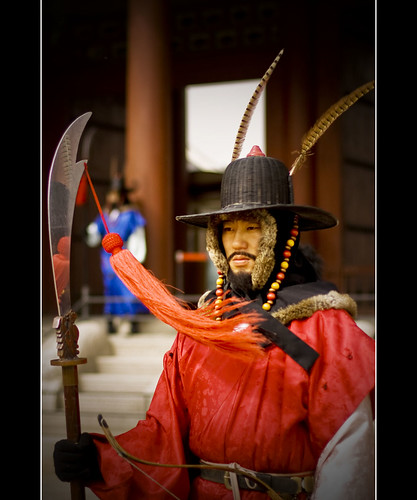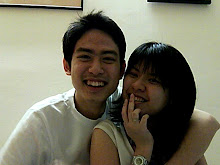»Day #1 - Acquainting Seoul
Day #2 - Korean Wave
Day #3 - A Sip of Soju
Day #4 - A Cultural Evening
20 February 2009, Friday
"Okay, there's one thing you might want to know," Adrian said on the way to Shindorim station. "Here in Seoul, you always get old ladies coming to you for road directions."
True enough, without suspecting me as a foreigner, I bumped into quite a number of lost aunties at the subway. Had I not been informed by Adrian, I would have even believed I had a considerable following of fans. As much as I would like to help them, I myself was equally at loss, since it was my first day in Seoul and I was travelling alone. In fact, I was practically checking the subway map every time the train made a stop, lest I should have boarded the wrong train and end up in Pyongyang.
Okay, before I digress any further, here's a summary of what I did on the first day.
Visibility was very poor that morning. The strong wind from northern China brought along with it yellow sand from the Gobi Desert. It reminded me of the haze that shrouds Malaysia every year during the dry season. (Thanks to the burning of forests in Indonesia!)

My first stop was the War Memorial Museum (전쟁기념관; 戰爭紀念館) at Samgakji station (삼각지). For those who are interested in knowing the history that divided the nation into the North and the South, this might be a good place to start.
Long before the period of the Three Kingdoms (of Baekje, Goguryeo and Silla), the country had been constantly at war. It was Silla that eventually unified the nation. But unfortunately, just to quote from the movie Red Cliff: From division comes unity, and from unity, division. Hence, it wasn't long before the unified Silla separated into three kingdoms again and wars broke out between them. The period was known as the Later Three Kingdoms. It was after the this period that the nation reached its peak during the Goryeo and Joseon Dynasties.
I know all this history scares most people away but just bear with me a little more. The development that occurred next marked a turning point in Korea's history - the Japanese occupation. Although Korea had been relentlessly invaded by Japan throughout its history, it was not until 1910 that Japan forcibly annexed Korea and ruled the nation for 35 years until 1945. That three and a half decades under the Japanese rule dealt a big blow to the people's pride. (More about that later in Day #5.)
After the Japanese occupation came to an end, the nation was split into two at the 38-th parallel. The Northern part was controlled by Russia; the South by America. But soon after America pulled out from South Korea, the Korean War (1950-53) broke out. Seoul at the center of the peninsula yo-yo-ed back and forth, changing powers four times during the brief period. It was with the help of the UN troops that South Korea managed to wrest back half of the peninsula.
No treaty was signed though; the North and the South are merely under ceasefire. In fact, South Korea still constantly faces threats from the North. That being said, I wasn't very much surprised to find leaflets about "Emergency procedures for chemical, biological, nuclear and radiation attack" in the museum. So, Cholong wasn't joking after all when she commented that South Korea is a very dangerous place.

My next stop after the War Memorial Museum was Gyeongbokgung (경복궁; 景福宮) the main palace of the Joseon Dynasty, constructed by King Taejo. There're five palaces around Seoul, this being the largest one.
Standing sentinel at the gate were the palace guards armed with broad swords, bows and arrows. Whether it was Korean pride about their culture, or the effort of promoting tourism that kept this tradition going, I do not know. But you've got to salute these guards for their spirit. It was a windy day and the temperature dropped to around 0゜C. Despite the freezing cold, they remained at their posts for an hour till the guards-changing ceremony. They didn't even get to walk around, mind you. All they could do was standing still. Curious foreigners - me included - would then come to them and have their photos taken so that they could later boast, "Hey dude, look! I took a photo with the Korean palace guard! Cool, eh?"
Entering the palace, I immediately found a Chinese tour guide and simply tagged along. Nearby, there was a Japanese guide too. Heheh, that's one of the biggest merits of knowing more than one language.
Obviously, the palace was very much influenced by Chinese architecture. The twelve animals from the Chinese Zodiac could be seen on the walls of the main hall that housed the throne. This perfectly symbolizes the idea that the King was the central of the universe.
Looking up at the roofs of the buildings, you could also see five curious figures. These, I later found out from the Gyeongbokgung Museum, are the characters from the Journey to the West: the monk, the monkey, the pig, the river monster and the horse. Finally, tagging along behind this troop of legendary characters is a dragon. But until now, I've no idea what the Journey to the West has to do with Korean culture.
Also, remember the floor heating system I talked about? You know what? The palace had it too! The buildings were built slightly higher than the ground. Then firewood would be burnt during winter to warm up the floor.
Now I'm not going to post anymore of those clichéd photos. It has been photographed to death by tourists who throng the place. You can easily check out the photos from the Internet.
I didn't really get the chance to explore the whole place because the wind was too strong. Instead, I eventually had to seek shelter at the museum while waiting for my friend, Cholong to show up and go for dinner. Oops, come to think of it, I skipped lunch that day.
We headed towards Insa-dong nearby, indisputably another tourist scene where most people stop by for souvenirs. Here's where you can find the most special Starbucks in South Korea, one whose signboard is written in hangul: 스타벅스, thanks to the protests from traditionalists concerning the opening of a Western shop in the traditional area.

After dinner and a brief stroll in the area, we braced ourselves against the freezing wind and walked all the way to Cheonggyecheong (청계천; 淸溪川).
Anyone who goes to Seoul has to visit this (whoa!) $900 million river. Spanning 6km across central Seoul, it has become a famous recreational spot since 2005. But when you spend such an astronomical amount of money on an urban renewal project without being able to justify the benefits it brings to the city, you'll certainly draw criticism from all quarters.
Despite that, though, the then-Seoul mayor who proposed the controversial project gained popularity and soon became the current president of South Korea. That's dear President Lee Myung-bak.
Roads in Seoul are way wider than those in Japan, I observed. I suppose it's because, unlike Japan, Seoul has plenty of land to spare; Japan overcomes this problem by building elevated highways. It's normal to see up to three or four level tall highways in Central Tokyo.

The city has also a considerable amount of skyscrapers. It's impressive how Seoul developed into its current state after being completely devastated during the Korean War. No wonder the South Korea's economic boom is often said to be a miracle. Unfortunately, being a nation that depends mainly on its exports, South Korea is suffering terribly from the recent global recession. Whether the country can realize another miracle or not, is of great interest to its neighbouring countries.

3 persons flung their shoes:
three and a half decades under the Japanese rule dealt a big blow to the nation's progress. (More about that later in Day #5.)
I think you might be misunderstood by korean propaganda
http://www.youtube.com/watch?v=-JHeghTfaVU
http://www.youtube.com/watch?v=rk3-YzsugcY
http://www.youtube.com/watch?v=JESc4H0awH0
I recommend to read her book,Korea and her Neighbours (1898)
http://en.wikipedia.org/wiki/Isabella_Bird
there are so many books abou korea that were written by foreigners
hoihoi51> thanks for the links. i'll refrain from making further comments before reading up more on the matter.
as for the statement, i think it'd more appropriate to rephrase it as "three and a half decades under the Japanese rule dealt a big blow to the people's pride."
I dont know what korean ppl's pride
they are still in korean sinocentrism.
most them are youger generation
old ppl dont talk much because it is said traiter..
when Park Chung-hee became the korean president, he said to shintaro ishihara like this
sorry in japanese
http://en.wikipedia.org/wiki/Park_Chung-hee
月刊正論2003年1月号【産経新聞70周年記念講演】
日本よ、自ら信じ自ら運命を切り開け(作家・東京都知事 石原慎太郎)
・・・・・ その判断(日韓併合)を、ある意味で冷静に評価したのは韓国の大統領だった朴正煕さんだ。私も何度かお目にかかった。あるとき、向こうの閣僚とお酒を飲んでいて、みんな日本語がうまい連中で、日本への不満もあるからいろいろ言い出した。朴さんは雰囲気が険悪になりかけたころ「まあまあ」と座を制して、「しかしあのとき、われわれは自分たちで選択したんだ。日本が侵略したんじゃない。私たちの先祖が選択した。もし清国を選んでいたら、清はすぐ滅びて、もっと大きな混乱が朝鮮半島に起こったろう。もしロシアを選んでいたら、ロシアはそのあと倒れて半島全体が共産主義国家になっていた。そしたら北も南も完全に共産化された半島になっていた。日本を選んだということは、ベストとはいわないけど、仕方なしに選ばざるを得なかったならば、セコンド・ベストとして私は評価もしている」(拍手)。
いや、こんなところで拍手しなくていい。
朴さんが、「石原さん、大事なのは教育だ。このことに限ってみても、日本人は非常に冷静に、本国でやってるのと同じ教育をこの朝鮮でもやった。これは多とすべきだ。私がそのいい例ですよ」と言う。
「私は貧農の息子で、学校に行きたいなと思っても行けなかった。日本人がやってきて義務教育の制度を敷いて子供を学校に送らない親は処罰するといった。日本人にしかられるからというんで学校に行けた。その後、師範学校、軍官学校に進み、そこの日本人教官が、お前よくできるな。日本の市谷の士官学校に推薦するから行けといって入学。首席で卒業し、言葉も完璧でなかったかもしれないが、生徒を代表して答辞を読んだ。私はこのことを非常に多とする。相対的に白人がやった植民地支配に比べて日本は教育ひとつとってみても、かなり公平な、水準の高い政策をやったと思う」・・・・・
there were 11 korean diet member in the Japanese parliament
korea was better treated more Taiwan.
however. taiwanese ,They evaluate it to positive etc.
for example like him
Mynor King, Artist:
I was there during the occupation of Japan. It's very funny, even though we were dominated or controlled by the Japanese, if you ask any people about the age of 65 years old, everybody really appreciates the life we enjoyed there instead of right now. It's very interesting.
http://www.kqed.org/w/baywindow/taiwan/japan.html
Hong Sa-ik
http://en.wikipedia.org/wiki/Hong_Sa-ik
Just check this story
http://www.tamanegiya.com/kousyoubunn.html
Post a Comment